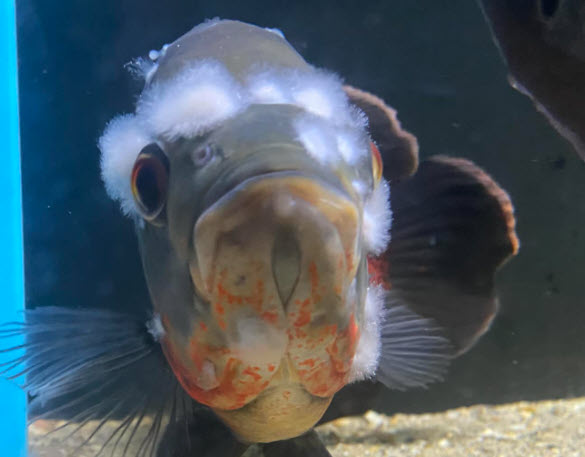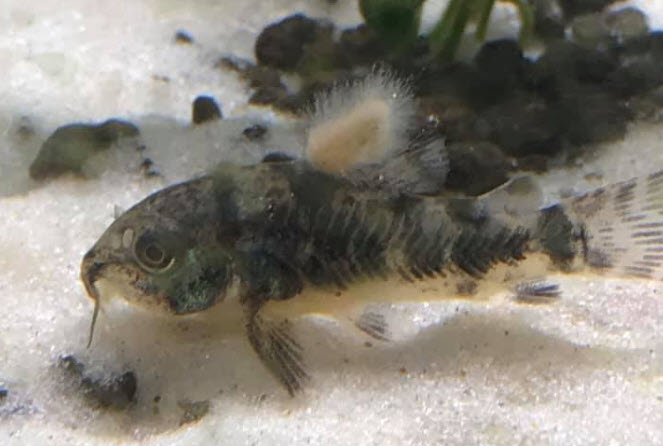
“Fungus” or Saprolegnia Summary
“Fungus” on a fish is typically a ball of white filaments sticking out well beyond the skin of the fish. The term “fungus” is a misnomer as these are not truly a “fungus”, they are saprolegnia water mold, a distant relative of the diatom. Most saprolegnia infections are either secondary to a bacterial infection or a bacterial infection mistaken for a saprolegnia infection. So adding an antibiotic like Maracyn 2 or Kanaplex to the food and only the food becomes very important.
The best treatment for saprolegnia per se is formalin/malachite green (Ich-X, Rid-Ich Plus, Blue Planet White Spot Remedy, Waterlife Myxazin and Mardel QuickCure) at the same strength as ich treatment. Methylene blue is another preferred medication. There are also a whole host of disinfectant medications which are effective at the right concentration. Potassium permanganate, iodine, chloramine T and hydrogen peroxide have all been successful against saprolegnia.

What does a “Fungus” (i.e. Saprolegnia) Really Look Like?
Saprolegnia needs to be carefully differentiated from a bacterial infection (typically columnaris). Saprolegnia is often called “cotton wool disease” because it looks like clumps of fuzzy wool on a fish. If it is saprolegnia the infection will be quite fuzzy and prominent, sticking out well beyond the skin of the fish. Columnaris on the other hand looks like a flat white fuzzy area, much like a piece of velvet stuck to the skin of a fish.
The most common presentation of saprolegnia infection is trailing white streamers of white filaments. Alternatively it presents as a secondary infection with a mix of bacterial and fungal species in a white very cottony structure. If you look very closely on the cottony growth you will typically see little balls at the end of each filament sticking out. These little balls are the spores.
New lesions are white, due to the mycelia of the Saprolegnia, and over time may rarely become red, brown, or green as a result of trapping algae or debris. When the fish are removed from the water they appear to have a “slimy” matted mass growing out of the skin and scales.

What is Saprolegnia?
In recent years taxonomists have recognized that Saprolegnia is not a “mold” or a “fungus”. It looks just like a type of true “fungus” called a “mold”, with radiating hyphae and spores. But in truth this is a classic case of parallel evolution. Saprolegnia is a “water mold” or “oomycete”, most closely related to the diatoms (“chromophyte algae”) that form as “brown algae” in the aquarium. True “molds”, on the other hand, are true fungi, closely related to mushrooms.
“Pathobiology of Water Molds in Fish: An Insight into Saprolegniasis”, Kathryn Liberman, 2017,
“Saprolegnia is an aquatic oomycete that affects many organisms, particularly freshwater salmonids in the aquaculture industry. Although oomycetes (commonly referred to as ‘water molds’) appear to have fungal characteristics, they are classified as Stramenopiles and are more closely related to chromophyte algae (van West 2006; Sarwowar et al. 2013).”
This disease will progress rapidly, it is not unusual for large lesions to suddenly appear within 24 hours. After time the infected tissue will slough off, leaving a large crater-like hole, surrounded by dark red or white muscle.

Research on Saprolegnia
There are a lot of articles on saprolegnia in aquaculture. It is called “Winter Fungus” because it is a disease which generally kills lots of cultured fish like catfish or tilapia in the winter when the temperature drops very low. This is not how it presents in the aquarium. So most of these articles do not apply to the aquarium.
“Stress and Diseases, 9.6.1 Saprolegniasis”, Abdel-Fattah, 2020
“Low water temperature is a main reason for the spread of Saprolegniasis. Lightner et al. (1988) reported 100% mortality of O. mossambicus, O. aureus and tilapia hybrids (O. mossambicus × O urolepis hornorum) caused by Saprolegnia due to low water temperature (<15°C). A mass mortality caused by S. parasitica was also reported in Egyptian fish farms in Kafr El-Sheikh Governorate during overwintering (Noor El-Deen et al., 2018).“
Most aquariums do not go down to 15 degrees Celsius (60 degrees Fahrenheit). Also the stocking in these fish farms is much heavier (like 20 times more) that even very heavy stocking in an aquarium. And the amount of bioload and bacteria in the water is typically much higher than in any aquarium. So one does not see mass infections of multiple aquarium fish with saprolegnia. It is virtually always just one fish in an aquarium.

Many well-intentioned commentators on social media quote these aquaculture articles on saprolegnia and make all sorts of claims on the basis of such articles. These commentators are simply wrong. The articles do not apply in the aquarium.
Saprolegnia is present in virtually all aquariums (the spores float around in the air everywhere!). It is the white “biofilm” seen on wood when it is new to the aquarium. In virtually all cases on aquarium fish there was a wound or a disease which created a patch of dead skin and the saprolegnia attacked that dead skin. There is almost always an underlying bacterial infection beneath the saprolegnia.

Treatment
Saprolegnia is a very serious disease which typically only attacks one fish in the tank. The prognosis for most fish with saprolegnia not good, most quite honestly will die even with aggressive treatment.
Water molds have very thin walls made of cellulose. These thin walls are easily penetrated by a whole host of antiseptics. So treating saprolegnia per se is pretty easy. But saprolegnia is generally secondary to a bacterial infection and treating the bacterial infection is harder to do.
The best treatment for saprolegnia per se is formalin/malachite green (Ich-X, Rid-Ich Plus, Blue Planet White Spot Remedy and Mardel QuickCure) at the same strength as ich treatment.

Some other research on treatments includes: “In vitro Activity of Chemicals and Commercial Products against Saprolegnia parasitica and Saprolegnia delica Strains”, Tedesco et. al. 2018:
“At present, no alternative treatment with effectiveness comparable to malachite green has been found for Saprolegnia infections (Sudova, Machova, Svobodova, & Vesely, 2007). Malachite green has long been used in aquaculture (Foster & Woodbury, 1936) as effective fungicide, and for the treatment of protozoan infections (Ichtyophthirius sp., Rahkonen, Koski, Shinn, Wootten, & Sommerville, 2002). Treatments with malachite green were administered either as monocomponent baths or as multicomponent baths (in combination with formaldehyde and other products) (Sudova et al., 2007).”
“Formalin, a solution of 37% formaldehyde, has been effectively employed to prevent (Bly, Quiniou, Lawson, & Clem, 1996; Schreier, Rach, & Howe, 1996) and treat (Cline & Post, 1972; Marking, Rach, & Schreier, 1994; Walser & Phelps, 1994) Saprolegnia infection in fish eggs. As a prophylactic measure, it inhibits cyst germination at a concentration of 250 mg/L (Bly et al., 1996). Daily flushes of formalin with 100, 200 and 400 mg/L increased per cent hatch of channel catfish Ictalurus punctatus eggs in comparison with non‐treated eggs (Walser & Phelps, 1994).”

“Fish Diseases and Disorders” Volume 3, Woo and Bruno, 2011:
“Malachite green has been used successfully for treating all infectious stages of Saprolegnia in fish aquaculture facilities worldwide (Foster and Woodbury, 1936; Olah and Farkas, 1978, Bailey, 1984, Alderman, 1985, Willoughby and Roberts, 1992 Bailey, 1983, Marking et al., 1994, Srivastava and Srivastava, 1978, Hataiet al., 1994, Yuasa and Hatai, 1995, Cline and Post, 1972,)
Formalin, an aqueous solution containing approximately 37% formaldehyde by weight, has been widely used to control oomycete infections in aquaculture (Cline and Post, 1972; Walser and Phelps, 1993).
Hydrogen peroxide another preferred medication. “Fish Diseases and Disorders” Volume 3, Woo and Bruno, 2011:
Hydrogen peroxide is effective against a variety of organisms, such as bacteria, yeasts, viruses and fungal and oomycete spores, and is potentially an important oomyceticide for fish culture, exhibiting little environmental impact (Schreier et al., 1996, Dawson et al.1994, Marking et al.1994, Waterstrat and Marking,1995, and Schreier 1996,)

There are also a whole host of disinfectant medications which are effective at the right concentration. Methylene blue, potassium permanganate, copper, iodine, chloramine T and hydrogen peroxide have all been successful against saprolegnia.
“Should the fish develop saprolegniasis, a variety of external disinfectants may be used. These include use of malachite green, copper sulfate, potassium permanganate, and formalin.” (Devashish Kar, 2016)
“Potassium permanganate (KMnO4) and hydrogen peroxide (H₂O₂) were also effective in treating Saprolegnia parasitica infection” (Sherif and Abdel–Hakim, 2016)
Note that because saprolegnia is not actually a fungus, fungicides do not work on Saprolegnia.
.

Since most of the time a saprolegnia infection is a secondary infection after a primary bacterial infection, it is generally recommended to also treat all saprolegnia infections with antibiotics like Kanaplex or Maracyn 2 in the food.
It is easy to make medicated food. Heat 1/4 cup water (two ounces or 58 milliliters, not a lot) in the microwave. Then blend one 1/4 ounce of plain animal derived gelatin (Knox gelatin, one envelope) into the hot water with vigorous stirring. Take two tablespoons of dry commercial fish food (pellets or flake) and mix it with just a little of the hot water/ gelatin mixture. Add hot water/gelatin until you get a paste like consistency. If it gets too watery just add more food.
Then add just a “smidgen” (roughly 1/16 teaspoon, a 1% to 2% addition) of medication to the mud. If you are using more than one medication mix the medications together, then use just a “smidgen” of the mixture. If you are using a packet of medication, take just a “smidgen” of the packet contents. Mix and mash the whole mass thoroughly. Spread it out into a pancake about 1/8th inch (3 mm) thick on a plastic film or a plate. Then put in the refrigerator. If you plan on keeping it for more than two weeks put it in a small plastic bag and freeze.
Feed it to your fish for one month. Note while the fish won’t eat it like they normally do, they typically will eat some if you just leave it in the tank.

Note that putting medication into the food seems to be a controversial topic, largely because it considerably reduces the amount of money that manufacturers make with their products (ahhh gotta love the profit motive). Bacterial disease can ONLY be treated with antibiotics IN THE FOOD AND ONLY IN THE FOOD. See this link:

Fish Eggs
Fish eggs are very prone to attack by saprolegnia. Treating fish eggs with formalin/malachite green or methylene blue prophylactically is always a good idea.
Bacterial Infections
Flat white spots that are fuzzy, like velvet, are almost always bacteria, not a saprolegnia (colonies of bacteria in a Petri dish are fuzzy!). These spots are very commonly called “fungus” by newcomers to the hobby. They aren’t a fungus or a saprolegnia. They are a bacteria, typically but not always a columnaris bacteria.
Treat with an antibiotic in the food per the directions above.

.
.
Aquarium Science Website
The chapters shown below or on the right side in maroon lead to close to 400 articles on all aspects of keeping a freshwater aquarium. These articles have NO links to profit making sites and are thus unbiased in their recommendations, unlike all the for-profit sites you will find with Google. Bookmark and browse!
.

